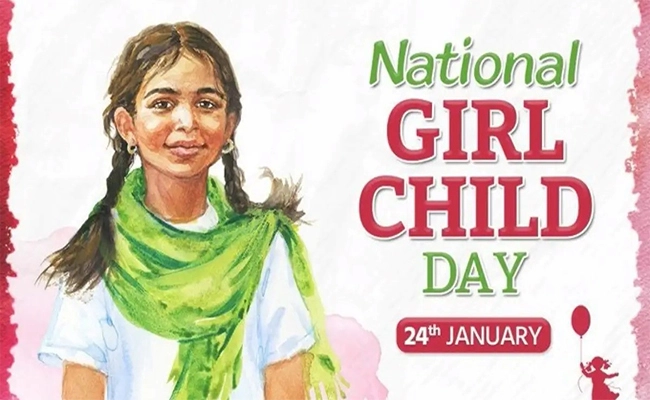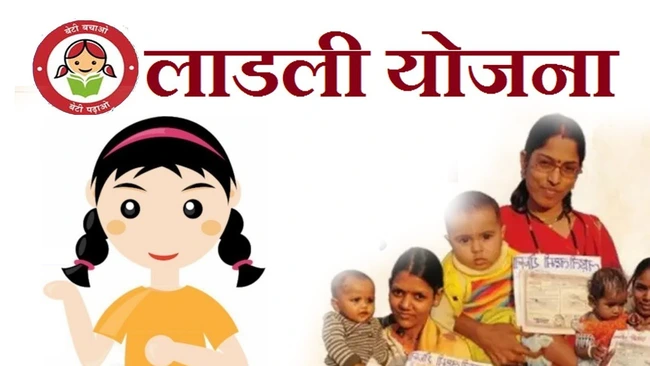National Girl Child Day 24th January 2024: History, significance, Laws, Schemes
By KnowledgeVeto Tuesday, January 23, 2024 16:00

© Images Provided By (AP Photo/ Ebrahim Noroozi)
'A world without girls is as inconceivable as one without water.'The world could come to a halt without the existence of a girl child. As a result, every year on January 24, National Girl Child Day is observed to raise awareness and support the rights, education, health, and nutrition of girl children throughout the country. The Ministry of Women and Child Development launched the day to provide support and opportunities for females in India.
National Girl Child Day 24th January 2024: History and significance
The Ministry of Women and Child Development established the day in 2008 to increase awareness about the importance of the girl child. An endeavor to reduce gender inequality in society and modify attitudes toward girls in this male-dominated culture. The government has implemented numerous projects for the development of girls, including Save the Girl Child, Bati Bachao Beti Padhao, and many others.
The day is notable because it focuses on the empowerment of girls, who are slain, aborted as a result of sexual abuse, endure gender inequity, and are denied many chances that boys have in society. So, on this day, numerous ministries and organizations host programs to empower girls for their advancement. The central and state governments also launch initiatives and policies to promote the development of girl children across the country.
The Significance Of National Girl Child Day
National Girl Child Day is more than just a calendar date. It provides a forum for reflecting on both the progress made and the challenges that remain in promoting girls' well-being and empowerment in a variety of areas, including education, health, and social equality. It serves as a compelling reminder that:
i) Girls deserve equal opportunities.
Every girl, regardless of origin or circumstance, has the right to an education, healthcare, and other basic necessities. This day emphasizes the need of removing obstacles and promoting inclusive development.
In one of the Famous Granth Sri Guru Granth Sahib Ji (Written)
"So Kyon Manda Aakhiye Jit Jamme Rajan" (On female gender equality: "Why to call 'her' inferior? From her, the Kings are born") ~ Guru Nanak Dev Ji
ii) Empowering girls empowers communities.

herzindagi.info
When females are educated and empowered, they become changemakers. They help to advance social and economic development, breaking the cycle of poverty and setting the path for a more fair future.
iii) Challenges persist, but so does hope.
While great progress has been made in areas such as female child education and healthcare, issues still remain. National Girl Child Day provides an opportunity to address these difficulties and renew our commitment to finding answers. (Here's How You Can Help Girls' Education.)
On National Girl Child Day, numerous events, seminars, and awareness programs are held across the country. Schools, colleges, and community organizations frequently hold events to educate people about the rights of girls, the importance of gender equality, and the need to end discrimination and violence against girls.
Government activities (Laws That Protect Daughters In India) may involve the implementation of new regulations or campaigns to address specific difficulties encountered by girls, such as enhancing access to education and healthcare, as well as maintaining a safe environment. Non-profit organizations frequently utilize this day to highlight their efforts in empowering girls and women and to solicit funding for their projects.
Laws for Women in India

The Times of India
In India, there exist laws that protect women's rights in areas such as family law, criminal offenses, employment circumstances, and property ownership. Our constitution provides rights to ensure the protection and progress of women. In this section of the article, we will look at the laws that protect women in India.
The Protection of Women from Domestic Violence Act, 2005
The Protection of Women from Domestic abuse Act of 2005 is one of India's important Acts and legislation for women, designed to protect women who are victimized by domestic abuse. Husbands who harass, assault, or maltreat women in their own homes face stringent legal consequences. The law seeks to offer protection orders, residency orders, and monetary compensation to ensure their safety and well-being.
Read more...MINISTRY OF WOMEN & CHILD DEVELOPMENT
The Dowry Prohibition Act, 1961

MYADVO
The Act's primary goal was to put an end to the dowry system in India. It fully forbade the offering and receiving of dowry. It also tries to protect women who want to marry but are unable to do so due to unreasonable dowry demands from the potential groom's side. However, there are still many dowry cases, and it has been extremely difficult to implement this rule due to the country's large population and cases not being filed out of fear.
Read more...MINISTRY OF WOMEN & CHILD DEVELOPMENT
The Sexual Harassment of Women at Workplace (Prevention, Prohibition, and Redressal) Act of 2013.
It addresses sexual harassment of women in the workplace. It establishes a legal foundation that will serve to limit such harassments and safeguard women, resulting in a safe and equitable working environment free of sexual harassment and abuse. The Act requires the formation of internal committees and the implementation of the POSH Policy in order to address complaints and resolve cases as quickly as possible.
Read more...National Portal of India
The Medical Termination of Pregnancy Act, 1971
The Medical Termination of Pregnancy Act of 1971 governs abortion in India. Under this statute, a woman may terminate her pregnancy after 20 weeks if it is necessary to save her life, if it endangers her physical or mental health, or if the pregnancy was caused by rape.
Read more...MINISTRY OF HEALTH & FAMILY WELFARE
The Maternity Benefit Act, 1961
Working mothers find it challenging to work during and before childbirth. Consequently, the Maternity Benefit Act of 1961 was enacted. Mothers are entitled to at least 12 weeks of maternity leave under the Act. The 2017 Amendment expanded this to a maximum of 26 weeks.
Read more...MINISTRY OF HEALTH & FAMILY WELFARE
The Equal Remuneration Act, 1976
The Equal Remuneration Act of 1976 (ERA) establishes gender-neutral and equality-based law that requires men and women to be paid equal remuneration for the same or similar labor, providing them with equal advantages and economic possibilities in the workplace.
Read more...MINISTRY OF LABOUR & EMPLOYMENT, GOVERNMENT OF INDIA
The Prohibition of Child Marriage Act, 2006
The Equal Remuneration Act of 1976 (ERA) establishes gender-neutral and equality-based law that requires men and women to be paid equal remuneration for the same or similar labor, providing them with equal advantages and economic possibilities in the workplace.
Read more...MINISTRY OF WOMEN & CHILD DEVELOPMENT
The Hindu Succession Act, 1956

legalupanishad.com
The Hindu Succession (Amendment) Act of 2005 gives daughters the right to property in mixed households. This legislation ensures that men and women are treated equally when it comes to inheriting property.
Read more...Legislative Department, Ministry of Law and Justice, Government of India.
The Indecent Representation of Women (Prohibition) Act, 1986
The statute prohibits indecent representations of women in any form, including literature, media, and ads. It tries to defend women's dignity and decency while also promoting respect for women.
Read more...MINISTRY OF WOMEN & CHILD DEVELOPMENT
The National Commission for Women Act, 1990 (NCW)
The (NCW) was established in 1990 with the passage of the NCW Act. Its principal purpose is to defend and enhance women's rights in India. The NCW aggressively addresses issues of gender-based discrimination, violence against women, and other breaches of women's rights.
Read more...THE NATIONAL COMMISSION FOR WOMEN
Four government schemes in India for girl child welfare
In India, where the cost of a girl's child's marriage is estimated from the moment she is born, the government must support the parents of girls' children through various welfare programs. Here are four Indian government projects for girls' child welfare.
1. Sukanya Samriddhi Yojana

wintwealth.com
Sukanya Samriddhi Yojana (SSY), was launched in 2015, in order to promote the welfare of girl child. We'd like two minutes of your time in order to understand you better. Please take this reader survey. It encourages parents to invest and build funds for the future studies and marriage expenses of the girl's children. The first investment is Rs 250, and subsequent investments are in multiples of 150 rupees, bringing the annual investment to 1.5 lakhs. The process continues for the next 15 years, after which the sum matures and is ready for withdrawal. This indicates that if you invest 1.5 lakhs annually for 15 years, you will have 43.5 lakhs compounded in your account at the current interest rate of 7.60 percent. The eligibility age is less than ten years old, which is correct because the money will only mature when the girls are ready to enter college. Benefits to be drawn from Sukanya Samriddhi YojanaIt is critical to understand that this plan is protected by a triple exemption, as it is exempt from tax under Section 80C of the Income Tax Act. Under the triple exemption, the amount invested, the interest earned, and the matured amount are all tax-free.
In many sections of the country, a girl's future is limited to marriage. This strategy not only assists parents in raising funds for wedding expenses, but it also covers the education costs of a girl's child, which are frequently forgotten.
The form for this plan is simply available at any India Post branch or any commercial bank that has been approved by the central government.
Given inflation, this scheme may not be particularly feasible. In 15 years, the 40-50 lakhs you have today would not be worth the same.
Furthermore, for persons living below the poverty line and in low-income families, having an annual salary of more than 1.5 lakh rupees is a distant dream.
For low-income families, parents of girls are already concerned about a variety of issues. Depending on their incomes, sending a girl's child to work (as domestic help) appears to be a more viable option for their parents than sending them to school.
2. Balika Samriddhi Yojana

The Balika Samriddhi Yojana is another national government project that assists females in financially challenged parts of society. This program ensures the enrollment and retention of female students in primary and secondary schools.
It strives to improve the well-being of a girl's child by providing a higher-quality education.
To be eligible for the Balika Samriddhi Yojana benefits, the girl's child must come from a low-income household.
One of the goals of the project is to prevent a girl's infanticide and to eliminate the shame associated with a girl's child's birth. The 2011 census revealed a child sex ratio (CSR) of 940 girls to 1000 males. However, the situation in some Indian states is more horrific.
As a result, projects like this are required to raise awareness and erase all stigma associated with giving birth to a girl. When females are not treated with happiness when they are born, such plans serve to motivate those who have daughters while also assisting the girls in becoming educated and self-sufficient.
This initiative also strives to ensure that no girl's child falls prey to child marriage and reaches the legal marriage age before being married off.
This plan looks after every girl kid registered under BSY and trains them in income-generating activities that will allow them to be financially independent and so lead their own lives by shattering all stereotypes.
The difficulty with this program is that it only includes girls children below the poverty line. The initiative would not include daughters from homes just above the poverty level who are also facing difficult circumstances.
The system needs to be a little more inclusive as females' child infanticides prevail in practically every part of society, irrespective of income size.
3. Beti Bachao Beti Padhao

pinimg
Among all the other girl's child welfare schemes, Beti Bachao Beti Padhao is the most popular.
Many schools and universities endorse this scheme under different means.
Some universities, in order to support the enrolment of students for higher studies, apply fee concessions on the registration and admission of female students.
This scheme celebrates girl children, literally translating to "Save the Girl Child, Educate the Girl child". It believes in women empowerment and creating an inclusive ecosystem for the same.
This plan aims to increase the safety of girls' children both before and after birth. Selective gender-based abortions continue to be prevalent in many places of India and are only getting worse, as seen by the 2011 census. A pregnant woman's family uses technology to determine the sex of the foetus, and the female foetus is aborted.
This system assures that females can inherit the family's property while simultaneously sending them to school and providing them with a higher-quality education.
It also aspires to eliminate all forms of discrimination and bias that females face, as well as provide inclusive advantages.
In short, this system ensures that women have a safe environment in which to survive and thrive.
The system involves three independent ministries: the Ministry of Women and Child Development, the Ministry of Health and Family Welfare, and the Ministry of Human Resource Development. Scheme applicants frequently encounter clearance hurdles, a lack of coordination among the three ministries, or gaps in civic administration.
No matter how flowery this approach appears, we still require rigorous on-the-ground monitoring.
4. Ladli Scheme

newsnationtv.com
The Haryana government started this plan under the state's Ministry of Child and Women's Development. Haryana is largely a male-dominated state, and the birth of a girl is regarded as a negative omen in many communities. As a result, this initiative was created to eliminate the stigma associated with the birth of a girl.
This strategy entails raising awareness about the importance of protecting girls in order to increase the state's sex ratio and provide adequate educational opportunities for females throughout the state.
This scheme is available to Haryana residents or those with parents from Haryana. One must show the domicile certificate.
The only method to benefit from this initiative is to register the mother and child at the local Aganwadi centre. The Ladli Scheme application form must be filled out completely. This scheme covers 5000 each year for five years (per household).
This arrangement rewards parents who have two daughters in the family. The money is deposited in the Kisan Vikas Patra and can be taken once the girl turns 18. A Kisan Vikas Patra account is formed under the mother's name.
In the event of the birth of a second child, the money is immediately paid to the parents in two installments to encourage the birth of a girl child and to ensure their education (in the future).
This program will assist reduce female infanticide, encourage girl childbearing, and assure higher-quality education. This program, which attempts to foster equality, applies to all people, regardless of caste, creed, color, or religion. It eliminates preconceptions and honors girl delivery in all states. It focuses on the entire socioeconomic well-being of the girl's child.
This scheme only applies to households with two girls, not those with three or more. Even in regions like Haryana, where infanticide is not practiced, the desire for at least one boy frequently results in the birth of a girl. This further restricts the rights of the females' children, who are soon forced into child marriage in order to relieve the parents of their financial burden.













